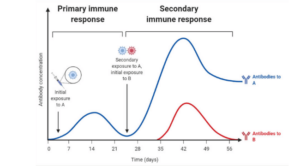Primary and Secondary Immune Responses: What’s the Difference?
During an initial immune response, antigen activates naive B cells, which then develop into antibody-secreting cells which make antibodies unique for the antigen that triggered the response. While the same antigen stimulates memory B cells, a secondary immunological response is induced, resulting in the generation of more specific antibodies than in the first response.
Differences Between Primary and Secondary Immune Response
| Characteristics | Primary Immune Response | Secondary Immune Response |
| Definition | The primary immune response is the reaction of the immune system when it comes into contact with an antigen for the first time. | The immune system’s reaction when it comes into contact with an antigen for the second and subsequent time is known as secondary immunological response. |
| Appearance |
It is most commonly detected in lymph nodes and the spleen. |
The bone marrow is the most affected, followed by the spleen and lymph nodes. |
| Occurrence | This occurs as a result of the antigen’s initial contact. |
This occurs after a second and subsequent encounter with the same antigen. |
| Antibody Peak |
The antibody level reaches its peak in 7-10 days. |
The antibody level reaches its peak in 3-5 days. |
| Affinity of Antibody |
They have a poor affinity for the antigens they are exposed to. |
They have a strong preference for their antigens. |
| Responding Cells | B and T cells are naive | Memory B cells |
| Antibodies | The major immune response involves both thymus-dependent and thymus-independent antibodies. |
In the secondary immune response, only thymus-dependent antibodies are involved. |
| Lag Phase | For a long time (4-7 days) |
In summary (1-4 days) |
| Types of Antibodies | During the main immunological response, a considerable amount of IgM and a modest amount of IgG are produced. | During the secondary immune response, a considerable amount of IgG and a little amount of IgM, IgA, and IgE are created. |
| Amount of Antibody | In the first immune response, only a few antibodies are generated. | The subsequent immune response produces 100-1000 times extra antibodies. |
| Strength of the Response | A significant amount of IgM and a minor amount of IgG are produced during the major immunological response. |
A significant amount of IgG and a minor amount of IgM, IgA, and IgE are produced during the secondary immune response. |
| Antibody level | The antibody level drops to the point where it may be undetectable. | Antibody levels tend to remain elevated for a longer period of time. |
Primary and Secondary Immune Response Citations
- https://www.mytutor.co.uk/answers/867/A-Level/Biology/What-is-the-difference-between-the-primary-and-secondary-immune-response
- http://pediaa.com/difference-between-primary-and-secondary-immune-response/
- https://www.differencebetween.com/difference-between-primary-and-vs-secondary-immune-response/
- http://www.yourarticlelibrary.com/difference/difference-between-primary–immune-response-and-secondary-immune-response-explained/11492
- http://www.yourarticlelibrary.com/immunology/difference-between-primary-and-secondary-immune-response-immune-response/27758
Related Posts
- Phylum Porifera: Classification, Characteristics, Examples
- Dissecting Microscope (Stereo Microscope) Definition, Principle, Uses, Parts
- Epithelial Tissue Vs Connective Tissue: Definition, 16+ Differences, Examples
- 29+ Differences Between Arteries and Veins
- 31+ Differences Between DNA and RNA (DNA vs RNA)
- Eukaryotic Cells: Definition, Parts, Structure, Examples
- Centrifugal Force: Definition, Principle, Formula, Examples
- Asexual Vs Sexual Reproduction: Overview, 18+ Differences, Examples
- Glandular Epithelium: Location, Structure, Functions, Examples
- 25+ Differences between Invertebrates and Vertebrates
- Lineweaver–Burk Plot
- Cilia and Flagella: Definition, Structure, Functions and Diagram
- P-value: Definition, Formula, Table and Calculation
- Nucleosome Model of Chromosome
- Northern Blot: Overview, Principle, Procedure and Results

















